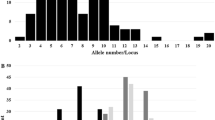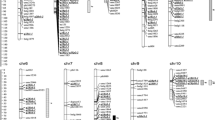Summary
Univariate and multivariate analyses were used to identify associations between eight enzyme marker loci and 11 quantitative traits of maize (Zea mays L.). The material analyzed included inbred lines Wf9 and Pa405, single-cross hybrid Wf9 X Pa405, and the F2 generation of the selfed single-cross hybrid. Each enzyme locus assayed was associated with at least one quantitative trait, and all quantitative traits were associated with genotypes at particular enzyme loci. Significant associations also were found between the level of heterozygosity per individual and nine of 11 quantitative traits. The total contribution to heterosis, for seed yield per plant, of genes linked with the eight enzyme loci, was 27% of the F2 mean and 18% of the difference in mean between the F1 hybrid and the inbred parents. Genes linked with Glu1 accounted for nearly one third of the total dominance effect detected by the eight enzyme loci. The chromosome segments marked by loci with significant effects on seed yield were markedly overdominant. The large heterotic effects of chromosome segments marked by particular loci suggest that enzyme loci could be used to help transfer genes responsible for heterosis to inbred lines. We conclude that analyses of additional inbred lines, F1 hybrids, and F2 populations in more environments will halp identify specific associations between enzyme loci, or chromosome segments which they mark, and important agronomic traits.
Similar content being viewed by others
References
Allard RW, Kahler AL, Weir BS (1972) The effect of selection on esterase allozymes in a barley population. Genetics 72:489–503
Brown AHD (1971) Isozyme variation under selection in Zea mays. Nature 232:570
Brown AHD, Allard RW (1970) Estimation of the mating system in open-pollinated maize populations using isozyme polymorphisms. Genetics 66:133–145
Brown AHD, Allard RW (1971) Effect of reciprocal recurrent selection for yield on isozyme polymorphisms in maize (Zea mays L.). Crop Sci 11:888–893
Clegg MT, Kahler AL, Allard RW (1978) Estimation of life cycle components of selection in an experimental plant population. Genetics 89:765–792
Copes OL (1975) Isoenzyme study of dwarf and normal Douglas-fir trees. Bot Gaz 186:347–353
Dixon WJ, Brown MB, Engelman L, Frane JW, Hill MA, Jennrich RI, Toporek JD (1981) BMDP Statistical software. University of California Press, Berkeley
El-Kassaby YA (1982) Associations between allozyme genotypes and quantitative traits in Douglas-fir (Pseudotsuga menziesii [MIRB.] Franco). Genetics 101:103–115
Evans DA, Wetter LR, Gamborg OL (1980) Somatic hybrid of Nicotiana glauca and Nicotiana tabacum obtained by protoplast fusion. Physiol Plant 48:225–230
Falconer DS (1981) Introduction to quantitative genetics, 2nd edn. Longman NY
Gamborg OL (1981) Application of somatic cell fusion to crop plants. In: Rachie KD, Lyman JM (ed) Genetic engineering for crop improvement. Rockefeller Foundation (USA), pp 162–182
Gates P, Boulter D (1979) The use of seed isozymes as an aid to the breeding of field beans (Vicia faba L.). New Phytol 83:783–791
Goodman MM, Stuber CW, Newton K, and Weissinger HH (1980) Linkage relationships of 19 enzyme loci in maize. Genetics 96:677–710
Gottlieb LD (1977) Genotypic similarity of large and small individuals in a natural population of the annual plant Stephanomeria exigua spp. coronoria (Compositae). J Ecol 65:127–134
Hamrick JL, Allard RW (1975) Correlations between quantitative characters and enzyme genotypes in Avena barbata. Evolution 29:438–442
Kahler AL (1983a) Effect of half-sib and S1 recurrent selection for increased grain yield on allozyme polymorphisms in maize (Zea mays L.). Crop Sci 23:572–576
Kahler AL (1983b) Inheritance and linkage of acid phosphatase locus Acp4. J Hered 74:239–246
Kahler AL, Clegg MT, Allard RW (1975) Evolutionary changes in the mating system of an experimental population of barley (Hordeum vulgare L.). Proc Natl Acad Sci (USA) 72:943–946
Kahler AL, Gardner CO, Allard RW (1984) Nonrandom mating in experimental populations of maize. Crop Sci 24:350–354
Kendall MG, Stuart A (1969) The advanced theory of statistics, vol 1. Distribution theory, 3rd edn. Hafner NY, pp 437
Ledig FT, Guries RP, Bonefeld BA (1983) The relation of growth to heterozygosity in pitch pine. Evolution 37:1227 to 1238
Mather K, Jinks JL (1971) Biometrical genetics, 2nd edn. Cornell University Press, Ithaca NY
Medina-Filho HP (1980) Linkage of Aps-1, Mi, and other markers on chromosome 6. Rep Tomato Genet Coop 30:26 to 28
Mitton JB (1978) Relationship between heterozygosity for enzyme loci and variation of morphological characters in natural populations. Nature 273:661–662
Mitton JB, Knowles P, Sturgeon KB, Linhart YB, Davis M (1981) Associations between heterozygosity and growth rate variables in three western forest trees. In: Conkle MT (ed) Isozymes of North American trees and forest insects. Pacific Southwest Forest and Range Experiment Station, Berkeley, pp 27–34
Nielson G, Scandalios JG (1974) Chromosomal location by use of trisomics and new alleles of an endopeptidase in Zea mays. Genetics 77:679–686
Nielson G, Frydenberg O (1971) Chromosome localization of the esterase loci Est-1 and Est-2 in barley by means of trisomics. Hereditas 67:152–154
Pollak LM, Gardner CO, Kahler AL, Thomas-Compton M (1984) Further analysis of the mating system in two mass selected populations of maize. Crop Sci 24:793–796
Pollak LM, Gardner CO, Parkhurst AM (1984) Relationships between enzyme marker loci and morphological traits in two mass selected maize populations. Crop Sci 24:1174 to 1179
Rick CM, Fobes JF (1974) Association of an allozyme with nematode resistance. Rep Tomato Genet Coop 24:25
Rick CM, Fobes JF, Holle M (1977) Genetic variation in Lycopersicon pimpinellifolium: evidence of evolutionary change in mating systems. Plant Syst Evol 127:139–170
Shaw DV, Allard RW (1982) Estimation of outcrossing rates in Douglas-fir using isozyme markers. Theor Appl Genet 62:113–120
Soller M, Brody T, Genizi A (1976) On the power of experimental designs for the detection of linkage between marker loci and quantitative loci in crosses between inbred lines. Theor Appl Genet 47:35–39
Stuber CW, Goodman MM, Moll RH (1982) Improvement of yield and ear number resulting from selection at allozyme loci in a maize population. Crop Sci 22:737–740
Stuber CW, Moll RH (1972) Frequency changes of isozyme alleles in a selection experiment for grain yield in maize (Zea mays L.). Crop Sci 12:337–340
Stuber CW, Moll RH, Goodman MM, Schaffer HE, Weir BS (1980) Allozyme frequency changes associated with selection for increased grain yield in maize (Zea mays L.). Genetics 95:225–236
Tanksley SD, Jones RA (1981) Application of alcohol dehydrogenase allozymes in testing the genetic purity of F1 hybrids in tomato. Hort Sci 16:179–181
Tanksley SD, Medina-Filho H, Rick CM (1981) The effect of isozyme selection on metric characters in an interspecific backcross of tomato-basis of an early screening procedure. Theor Appl Genet 60:291–296
Tanksley SD, Orton TJ (eds) (1983) Isozymes in plant genetics and breeding. Part B. Elsevier, New York
Tanksley SD, Rick CM (1980) Isozyme linkage map of the tomato: applications in genetics and breeding. Theor Appl Genet 57:161–170
Wetter LR, Kao KN (1976) The use of isozymes in distinguishing the sexual and somatic hybridity in callus cultures derived from Nicotiana. Z Pflanzenphysiol 80:455–462
Author information
Authors and Affiliations
Additional information
Communicated by H. F. Linskens
Cooperative investigations of the USDA, ARS and Dept. of Plant Sciences, South Dakota State Univ. (SDSU), Brookings, Journal Series No. 2039; and the Institute of Animal Resource Ecology, Univ. of British Columbia, Vancouver, B.C. V6T 1W5, Canada
Rights and permissions
About this article
Cite this article
Kahler, A.L., Wehrhahn, C.F. Associations between quantitative traits and enzyme loci in the F2 population of a maize hybrid. Theoret. Appl. Genetics 72, 15–26 (1986). https://doi.org/10.1007/BF00261448
Received:
Accepted:
Issue Date:
DOI: https://doi.org/10.1007/BF00261448




